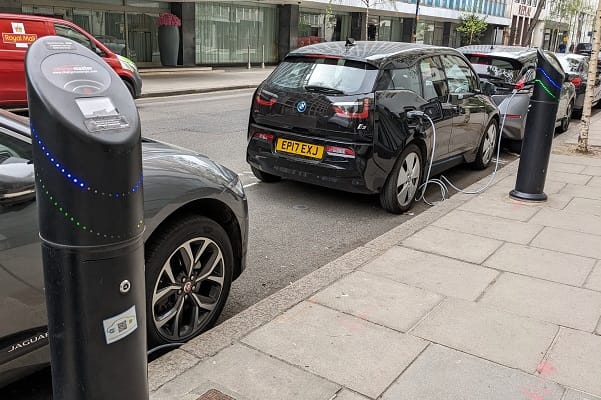With reduced emissions and lower operating costs, electric vehicles (EVs) have become a sustainable and innovative choice for many. However, as the cold weather rolls in, the winter months can present various challenges for EVs and their drivers.
To help drivers stay aware of the rules on driving an electric vehicle in the winter, The Electric Car Scheme has compiled some key tips to help them stay safe and their cars healthy. CEO, Thom Groot, has also provided expert tips on how to manage the impact of the cold temperatures on the range of electric vehicles.
Leaving charge point cables untidy during a recharge can land you up to a £130 fine
Highway Code: 239
Endorsement code: MS10
The cold weather can create all sorts of hazards for pedestrians, like the slippery leaves on the pavements, icy pathways, and even reduced visibility. So, while the cold might have you rushing to plug your car in, it’s important to make sure that you haven’t left the cables lying around for someone to trip over.
According to endorsement code MS10, leaving your vehicle in a dangerous position could land you with three penalty points and a fine of up to £130. The cost of the fine will depend on the seriousness of the offence and the council area you committed it in.
Penalty Charge Notices (PCN) issued outside of London range from £50 to £80, while fines issued inside the capital cost £130 or £80. You could also be subjected to a £50 non-endorsable Fixed Penalty Notice (FPN) for the negligent use of a motor vehicle.
The Highway Code rule 239 states that you should park close to the charge point and avoid creating a trip hazard for pedestrians from trailing cables. After using the charge point, you should return the charging cables and connectors neatly to minimise the danger to pedestrians.
Neglecting to clear your EV’s sensors of mud and snow could lead to a £100 fine
Endorsement Code: TS10 – TS70
Most modern vehicles rely on various sensors to understand their surroundings, navigate environments and adapt to various conditions. The camera sensors interpret the objects in the road around the car but poor weather conditions, like rain and snow, can limit their visibility.
If a vehicle’s sensors begin to fail or are damaged and you’re unable to comply with traffic signs you could end up with a £100 fine and three penalty points. Just as you would wipe your number plate clear of any debris, be sure to wipe your car’s sensors of any snow, mud, or other obstructions.
It’s important to make sure your sensors are working before setting off in freezing temperatures, so it’s a good idea to double-check they’re working correctly before setting off on a journey.
Driving before properly demisting your windows or clearing snow can result in a £1,000 fine
Highway Code: 229
The winter months can make your morning commute challenging. However, no matter how late you’re running, you should always take the time to ensure that you have full visibility of the road.
In line with endorsement code MS10, failing to have proper control of the vehicle or a full view of the road and traffic ahead can result in a penalty of £1,000 (£2,500 for PCV or goods vehicle). You could also gain three penalty points.
So that you don’t get hit with unwanted fines, there are a few things you need to take care of before setting off. Make sure that your windows are clear of ice, while also removing any snow that could fall and obstruct the path of other drivers. To ensure everyone’s safety, check that your lights and number plates are visible before climbing in and thoroughly de-misting your car’s interior.
Driving while wearing winter gloves, a beanie hat, and a scarf can land you a £1,000 fine
Highway Code: 229
Whether it’s a fashion choice or you’re simply protecting yourself from the cold, it’s important to keep your full attention on the road. Scarves, gloves and heavy coats could not only limit your mobility but also create unnecessary distractions.
Failing to have proper control of the vehicle or full view of the road and traffic ahead can result in a penalty of £1,000 or three penalty points. So, where possible, opt for cracking up your car’s heating to make the vehicle warm then wrap up in winter wear when you’re at your destination.
EV expert shares how to prepare your car for the winter months to avoid fines
Thom Groot, CEO of The Electric Car Scheme shares his top tips to help EV drivers prepare their vehicles for driving in winter conditions:
Preheat your car battery
When it comes to electric vehicles, the cold temperatures have a negative effect on the battery’s power output. A great way to maintain battery efficiency during the cold months is to warm up your battery before the start of every journey.
All you need to do is use the pre-conditioning function – you’ll even find smartphone apps that allow you to schedule your pre-conditioning, so you don’t have to wait too long to start your journeys in the morning. This not only warms your battery to the optimum temperature but also ensures the car is nice and warm when you get in.
Opt for a model that has a heat pump
One of the most notable bits of new technology that EVs have to try and boost their range — especially during winter — is a heat pump. A heat pump retains heat from the car’s battery and uses it to increase the range of the EV. Recent research has found that EVs fitted with a heat pump only fell short of their official range by approx 25.4%, whereas EVs without a heat pump saw a 33.6% deficit.
Change your tyres
The winter months can cause the rubber in your tyres to harden, leading them to lose traction. It’s a good idea to check the tread depth of your tyres to ensure that you have the legal minimum of 1.6 mm. Even if your tyres meet the legal threshold, having a higher tread depth will improve both your braking and steering capacities.
It might also be worth investing in winter tyres, which provide your car with better grip, allowing you to drive effectively in the rain, snow and ice. Bear in mind that electric vehicles are heavier than petrol cars, so check that the winter tyres have excellent grip and the ability to handle the increased weight.
Keep your car warm
A great way to keep your battery’s performance optimal is to leave your car covered when you’re not using it for an extended period of time. Whether you’re parking your car at home for the night, or even parking for work, try to leave your car somewhere inside.
Parking your electric vehicle in a garage will help keep up the battery’s temperature while also improving its efficiency during the winter months. If you don’t have a garage handy, cover your vehicle with a tarp or frost cover to protect it from the frost and ice.
Check your windscreen essentials
You’ll find yourself using your windscreen wipers often during the winter months, so it’s important your wiper blades are in good condition. If they don’t need changing, all you need is a good cloth to wipe them down with.
To help your wipers keep your windscreen clear, make sure you have enough screen wash. You can check this by opening the bonnet and checking the levels of the windscreen washer reservoir.
Improve the battery’s range
To avoid getting stranded during the cold months, make sure your EV has enough range for your trips. EV batteries tend to be less efficient during the winter, making it crucial to maintain your EV’s charge between 20% and 80%, thereby upholding efficiency and extending its overall lifespan.
With the winter months seeing your vehicle’s range reduce by 10-15%, especially if you have the heating on full blast. So, consider using the regenerative braking system to help save energy during your trips. The system captures kinetic energy every time you brake before sending it to the battery and increasing your overall range.
Thom advises, “EV drivers specifically need to be aware that cold temperatures impact their range. Many EVs feature an eco-mode that allows you to increase your mileage by reducing the energy supplied to the motor, allowing you to go further when it’s colder. Even without this function, you can extend your range by driving economically. Accelerating gradually and maintaining consistent speeds will not only maximise your energy efficiency but also help reduce the risks of winter hazards, like icy or wet roads.”
Mercedes EQS has the best winter driving range of 262.68 miles
An electric vehicle’s range is the distance it can cover on one battery charge, which varies depending on your car model and your driving habits.
EVs also rely on their battery to power things like heating, defrosting, and battery preconditioning. The cold can cause the battery’s performance to drop, affecting how far you can go with each EV model.
When analysing the range decrease from each EV’s standard range, to the estimated range when temperatures reach freezing, The Electric Car Scheme found that the Mercedes EQS came out on top with a 262.68-mile winter driving range. This is followed by the BMW i7 and Fisker Ocean having a 248.85 mile and 241.94 mile winter range respectively.
Thom states “All EVs will have a different mileage range based on a full charge, but as with the roads becoming tricker, the winter months also have an impact on the range of EVs. It’s important that you’re aware of the slight decrease in range when heading into colder temperatures so you can ensure your car is properly charged before any journey.
“However, there is a high amount of investment going into the advancement of electric vehicles with the technology and features behind them being constantly worked upon and improved. Over the coming years, we will continue to see the EV industry progress and become even more advanced.”





Leave a Comment